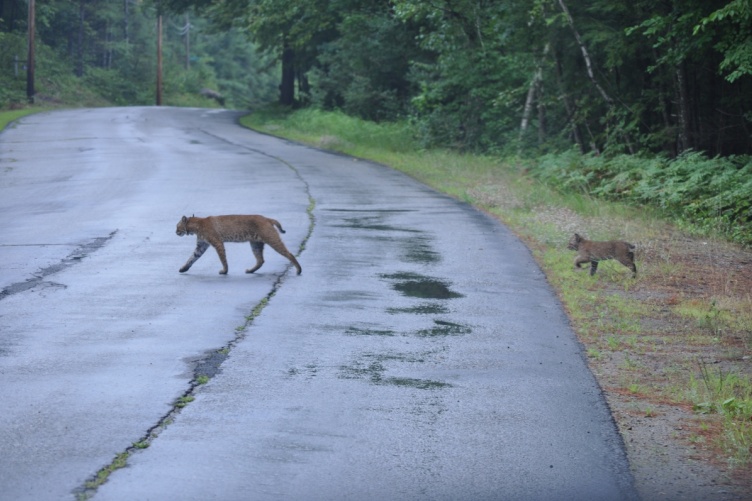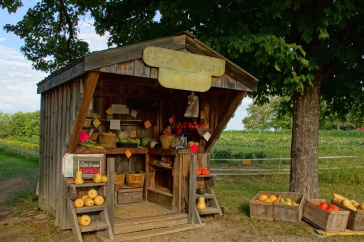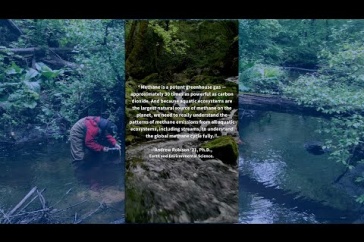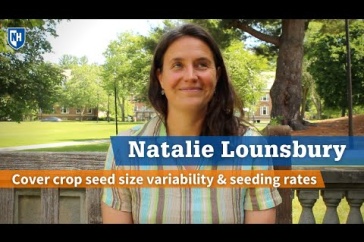
A female bobcat and her kitten cross a New Hampshire road.
New Hampshire’s bobcats are responding to the detrimental effects of roads – including possibly hunting in residential areas – as they continue to rebound and re-colonize in areas of the state with dense road networks and substantial traffic volumes, according to new research funded by the New Hampshire Agricultural Experiment Station at the University of New Hampshire.
The research was conducted by John Litvaitis, Gregory Reed, Rory Carroll, Marian Litvaitis, Jeffrey Tash, Tyler Mahard, and Derek Broman, all with the UNH Department of Natural Resources and the Environment, and Catherine Callahan and Mark Ellingwood with the New Hampshire Department of Fish and Game. The results are presented in the journal Environmental Management in the article “Bobcats (Lynx rufus) as a Model Organism to Investigate the Effects of Roads on Wide-Ranging Carnivores.”
“An obvious effect of roads is the loss of habitat by the road itself. But the effects of roads extend well beyond. Traffic noise, for example, alerts animals several hundred feet beyond the road. That noise causes some animals, including bobcats, to avoid roads. But in more developed regions of the state, it isn’t possible for bobcats to avoid crossing roads as they move through home ranges that are 10-square miles or more,” said John Litvaitis, professor of wildlife ecology at UNH.
New Hampshire’s bobcat population has rebounded since the wildcat was protected from hunting in 1989. UNH researchers estimate there is the potential for as many as 1,400 bobcats in the state.

UNH researchers looked at New Hampshire Fish and Game Department data on the deaths of bobcats from bobcat-vehicle collisions from 2008 to 2013 in six southeastern counties in New Hampshire. In addition, they used data from live bobcats outfitted with GPS collars in the same area. Predominately active at night, bobcats are most at risk for being hit by vehicles between 6 p.m. and 6 a.m. even though that time of day has a lighter traffic volume.
The researchers found that bobcats are particularly at risk of being hit by cars in areas with state and interstate highways, which have higher traffic volumes. Bobcats that make repeated crossings of high-volume roads have a greater chance of being struck by a car and killed. The collision research also suggests that some regions may function as demographic sinks – places where juvenile bobcats find suitable habitats but do not survive long enough to reproduce due to vehicle collisions.
However, despite the risks, bobcat road deaths are relatively modest and not likely having a substantial influence on New Hampshire’s growing bobcat population, the researchers found. They theorize that New Hampshire’s bobcats living in the southeastern area where high-traffic roads are more prevalent may be using underpasses and culverts to avoid crossing highways.
In addition, bobcats may be turning to hunting in residential backyards. Bobcats prey on small animals such as squirrels, rabbits, wild birds, and chickens.
“A number of residents in southeastern New Hampshire observed and photographed bobcats capturing prey in backyards, especially gray squirrels and wild turkeys that were attracted to bird feeders. In addition to enhancing winter survival of bobcats that have difficulty capturing prey during periods of deep snow, the concentrated prey associated with suburban settlements in winter may result in less frequent road crossings by bobcats,” the researchers said in the journal article.
“One resident reported that a juvenile bobcat spent several weeks underneath a porch from which it made regular forays to attack squirrels foraging at a nearby bird feeder. Thus, the availability of such prey may at least partially ameliorate the negative effects associated with an abundance of roads in developed areas,” they said.
Researchers identified four genetically distinct bobcat populations, and said high-traffic roads are serving as major barriers for bobcat movement. By looking at the genetic makeup of bobcats, researchers found that the genetic diversity of New Hampshire’s bobcats is being hampered by roadways, in particular Interstate 89, Interstate 91, Interstate 93, and State Highway 101. The highways are inhibiting bobcats from traveling to mate with bobcats that are more genetically dissimilar.
In evaluating the movements of bobcats outfitted with GPS tracking, researchers found bobcats prefer forests, shrub and scrub areas, wetlands, more rugged and steeper sloped areas with southern-facing slopes, and areas closer to streams. The southern areas of the state with low elevations are considered highly suitable habitats for bobcats.
Founded in 1887, the NH Agricultural Experiment Station at theUNH College of Life Sciences and Agriculture is UNH’s original research center and an elemental component of New Hampshire's land-grant university heritage and mission. We steward federal and state funding, including support from the USDA National Institute of Food and Agriculture, to provide unbiased and objective research concerning diverse aspects of sustainable agriculture and foods, aquaculture, forest management, and related wildlife, natural resources and rural community topics. We maintain the Woodman and Kingman agronomy and horticultural farms, the Macfarlane Greenhouses, the Fairchild Dairy Teaching and Research Center, and the Organic Dairy Research Farm. Additional properties also provide forage, forests and woodlands in direct support to research, teaching, and outreach.
-
Written By:
Lori Tyler Gula, PhD | NH Agricultural Experiment Station | lori.gula@unh.edu | 603-862-1452




















































